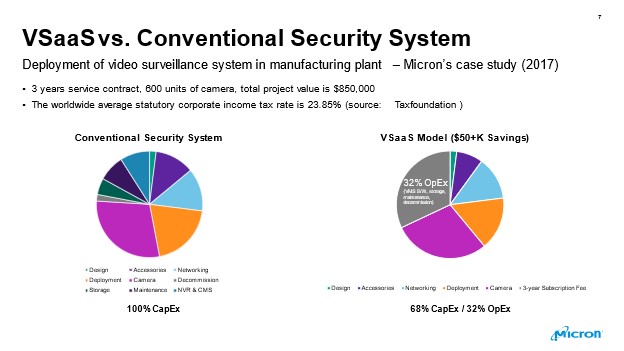


A Look Into Major Trends in VSaaS
Photo 161258217 © Freemanhan2011 | Dreamstime.com
Cloud and edge computing are driving video surveillance systems from on-premise managed schemes to cloud-based solutions. With the addition of software-as-a-service (SaaS) applications, the conventional video surveillance system is transforming into a Video Surveillance as a Service (VSaaS) model.
The global IP video surveillance and VSaaS market is growing, particularly in the residential and small-to-medium business sectors. Valued at $18.51 billion in 2018, the market is projected to reach $52.98 billion by 2026—registering a CAGR of 12.9% from 2019 to 2026. As a result, huge volumes of data will be produced, requiring system optimization among data storage, data processing and communication—revolutionizing the VSaaS model.
Security Technology Executive magazine (STE) recently discussed the future of VSaaS and how it can lower the TCO of a conventional video surveillance system, its operational benefits and how to select a suitable VSaaS solution for your business with David Henderson, the Director of Industrial Marketing for the Embedded Business Unit at Micron Technology
STE: What do you think are some of the most important technology and business operations drivers impacting the integration of video surveillance solutions into enterprise and mid-sized organizations today?
Henderson: There are several factors to be considered while designing video surveillance solutions for enterprise and mid-sized organizations.
One key element would be remote management capability. An organization that featured several facilities across different cities/states/countries/regions would require a centralized system with remote management capability.
Flexibility and upgradability are also critical factors driving this shift in video surveillance business operations. There are several examples that demonstrate the importance of system upgradability and scale-up capability. For instance, one example would be if a new facility deployment needed an existing video surveillance system to extend its coverage as a requirement of centralized management. Another example might feature a new deployment to address user’s requirements by adding new AI-enabled cameras into the existing video surveillance system.
Finally, the organization must consider the over total investment for the solution. A significant amount of upfront payment for equipment purchasing installation and maintenance service could be a barrier to some business owners because of the huge capital expenditure investment.
STE: Most organizations are struggling to find cost-efficient video surveillance solutions for their facilities. The concept of video surveillance as a service (VSaaS) is gaining more traction versus conventional surveillance systems options as a result. Can you discuss the reasons for this shift in technology and operations strategies?
Henderson: We know that conventional surveillance systems have been broadly used in enterprise and mid-sized organizations for years, but by adopting cloud technology, a VSaaS solution could offer a more cost-efficient option. From an industry perspective, here are some of the cost and operational benefits this solution might provide.
- Remote management across different sites -- A VSaaS solution, with its cloud-based architecture, offers cloud-VMS systems remote management and monitoring capabilities for multi-site surveillance camera systems. This open solution makes it easier for multi-site enterprise or mid-sized organizations to manage their video surveillance systems deployed across different facilities.
- System scalability and upgradability -- Other benefits can be derived from using cloud-based architecture that feature systems that are scalable and upgradeable. Users can easily add new cameras onto the VSaaS cloud as long as subscription plans are extended for these newly deployed cameras, allowing the client to enjoy the same service offered by the VSaaS vendor. Also, if future system expansion requires the addition of new features or services to their existing system, the process to add such things as extended storage retention or facial recognition would remain the same.
- Lowering Total Cost of Ownership (TCO) -- For most business owners, reducing expenses is a top priority and today’s advanced technology can help. Technology can not only increase business efficiencies, but it can also aid in lowering certain expenses. Case in point: cloud-based services.
The VSaaS implementation model where certain functionalities are paid with a “pay-as-you-go” model, like an annual subscription plan instead of a hefty upfront payment. In this way, the annual subscription fee can be classified as an operating expense (Opex), which may be deductible. This would subtract these expenses from revenue when calculating profit and loss. Compare this scenario with that of a conventional surveillance system implementation model which would be classified as a capital expenditure (Capex), it is easy to see why the VSaaS model would be a preferred choice for lowering your TCO.

STE: Does VSaaS offer flexibility that organizations can customize to meet their security and risk needs?
Henderson: Certainly. A VSaaS system can be categorized by its storage location and divided into three different models:
- Hosted VSaaS: Video is generated onsite and transferred over a network to the service provider’s data center where it is managed and stored. The recorded video at the service provider’s site is delivered over the cloud as a service.
- Managed VSaaS: Onsite video recording is stored at the customer site and remotely maintained, monitored, and managed over a cloud service.
- Hybrid VSaaS: A combination of hosted and managed VSaaS, the video is stored primarily onsite. Cloud storage is leveraged as a backup if redundancy or longer storage retention is required.
Considering the use cases for enterprise and mid-sized organizations, which could have a significant quantity of security cameras deployed onsite, bandwidth issues and networking reliability could become challenging to VSaaS solutions. In this case, a preferred model would be the Hybrid VSaaS which would use the capacity of on-premise storage to reduce the network bandwidth consumption and also incorporate cloud storage for redundancy or the extended storage retention requirements that ensure and enhance system reliability.
STE: Can you discuss what are the benefits of using edge storage in a hybrid VSaaS solution?
Henderson: Edge storage is the use of in-camera onboard storage as the primary storage option, and it becomes a preferred choice for the Hybrid VSaaS model because it offers these advantages:
- Lower storage acquisition cost: By adopting edge storage for the on-premise storage in a hybrid VSaaS model, the need for onsite recording systems is eliminated, resulting in a reduction of total storage acquisition cost (for example, the cost of NVR, installation and power consumption).
- AI integration and network load reduction: This allows for faster decision-making by incorporating edge-based real-time analytics and storage in a hybrid VSaaS model. It also reduces network bandwidth consumption for upload due to in-camera storage capability.
- Flexibility: Using edge storage offers more flexibility to allocate storage capacity for different storage retention requirements. (for example, 4K camera for 60 days storage, 1080p camera for 30 days storage, warehouse camera for 90 days storage, reception camera for 30 days storage, and so on.)
- Scalability: Adding a new camera with edge storage is easy--simply install the camera with onboard storage and cloud authentication.
- System reliability: Using edge storage helps reduce the risk of stop monitoring caused by local recording system downtime